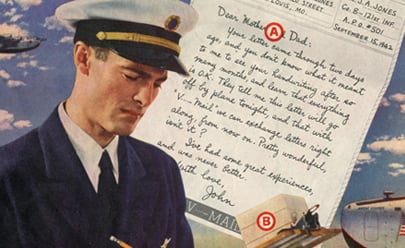Letters from loved ones are proven to be a great tool in boosting the morale of soldiers. This was especially so during the Second World War. But how did the postal service cope with the speed and how did they improve the storage and shipping of sending mail to the frontline?
V Mail was an essential tool to boost US soldiers’ morale during World War II. Shipping regular mail took so much space, so they photographed each letter and shipped the film instead. The photos were then printed at the destination.
The Mail Problem
The declaration of war on Japan sparked the largest full-scale wars in history. Millions of men enlisted to join the second world war, serving the US and helping win battles for the Allied forces. Most men traveled to unknown territories with fellowmen they didn’t even know. And most of them faced the fact that they may not make it home. (Source: DDay)
The armed forces quickly recognized that mail or care packages gave deployed service members a boost in morale, reminding them of their determination in getting the job done and the hope of coming home.
The Army Post Offices, Fleet Post Offices, and the US Post offices were flooded by mail sent to and from the soldiers in the frontline. An estimate of 2.5 million letters and packages were shipped around 1945. The sheer volume of the mail was beginning to be a logistical concern with the armed forces. Its bulk is eating up valuable space to transport other equipment needed for war. (Source: National Postal Museum)
The Concept of V Mail
Soon, the US Postal Services adapted what the British had been doing. The British army encountered the same issue, hence coming up with the Airgraph. The airgraph was a process invented by Eastman Kodak in the 1930s.
Letters would be written on premade forms. The standardized stationery used was 8.5 by 11 inches. These forms would be censored and scanned to a 16 mm microfilm. The microfilms would then be transported, and as soon as they reached their destination, the letters would be printed out on photo paper and delivered to their intended recipients.
The US called their version V Mail, short for Victory Mail. Its rollout proved to be more practical during wartime. Between 1,500 to 1,800 V Mail letters could fit in one 90-foot roll of film, and a roll of film only weighs four ounces.
To put that in perspective, mail delivery of 2,500 pounds of paper letters needed 37 mail sacks while its equivalent in microfilm was only 45 pounds and one mail sack. About 98% savings on cargo weight and space gave way to ship more supplies to the forefront.
The change from regular mail to V Mail also deterred any efforts for espionage. Since photocopies of the letters were sent, invisible ink and microdots were practically useless. The likelihood of letters getting lost was also down to a minimum. Every letter was assigned a serial number, and reprints were possible if necessary. Letters were also delivered faster, boosting the morale of the servicemen and keeping the candle of hope burning in their homes. V Mail service ran for 41 months during the war, with multiple stations created. (Source: DDay)
